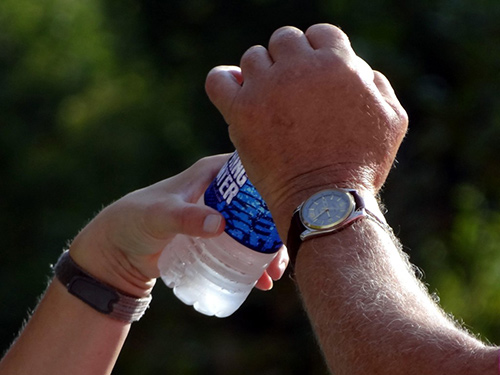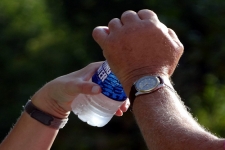
This heat and humidity - which, often times, extends well into the spring and fall months, as well – is virtually inescapable. This, in turn, winds up leading to all sorts of heat-related issues for pretty much anyone who spends time outside engaged in physical activity (be it playing sports, gardening, or spending the day at the local Farmers Market), ranging from mild ailments such as cramping, to life-threatening events like heat stroke.
It’s important to remember that heat injury is preventable! However, prevention hinges on understanding the causes, being able to recognize the symptoms, and knowledge of how to treat a heat injury will go a long way towards reducing the number of cases.
What Causes Heat Injury?
Upon exertion, the human body cools itself via sweating. And, as we sweat, we lose fluids that our body needs – if those fluids aren’t replaced, dehydration results. Dehydration, in turn, makes it difficult to sweat and cool down, which is how heat injuries occur. During exercise, between 70% and 90% of the energy our bodies produce winds up being released as heat. Factors that can hinder heat release and subsequent perspiration are:
Environment. Air temperature, combined with humidity, wind speed, and sun affect how well our bodies cool themselves. Humidity influences how easily sweat can evaporate. High humidity (greater than 60%) makes sweat evaporation very difficult.
Fitness level/acclimatization. Before exercising in the heat, athletes must be in good physical condition. They also need to give their bodies time to adjust to warmer temperatures.
Dehydration. Even mild levels of dehydration (3-5% of body weight) can hurt athletic performance. If you have not had enough fluids, your body will not be able to effectively cool itself through sweat and evaporation.
Pre-activity hydration status. Athletes who start activities in an already dehydrated state are at greater risk for heat injury. Factors that can affect your pre-activity hydration status include inadequate rehydration after a previous exercise session, alcohol consumption, rapid weight loss regimes (i.e. wrestling), and fever, vomiting, or diarrhea.
Clothing. Dark clothing absorbs heat. This can dramatically increase the chance of heat stress. Full body clothing, heavy pads, and helmets also make cooling more difficult.
Sun exposure. Direct exposure to the sun with no available shade can increase your core body temperature.
Age. Children adjust to heat more slowly than adults. Their bodies are less effective at regulating body heat.
High body fat. Athletes with high body fat have greater difficulty cooling themselves.
Fever. Anyone with a current or recent fever may be at increased risk.
Medications. Diuretics and stimulants may increase risk.
Sickle cell trait. Sickle cell trait or disease increases the risk for heat illness. This is especially true if good hydration and electrolytes are not maintained.
Types of Heat Injury
Heat cramps are typically painful cramps in the stomach and extremities (arm and leg muscles) which are caused by not replacing salt and fluids during intense, prolonged exercise in the heat. Treatment includes stopping the exercise or activity, stretching affected muscles, and rehydrating.
Heat Syncope (fainting) typically occurs by exercising/training hard in the heat, and is experienced as weakness, fatigue, and fainting. Heat syncope tends to occur within the first week of starting a new activity, as our bodies adjust to the new routine. Younger athletes who are returning to play after an extended period of down time (post-injury, etc) are also at a greater risk for heat syncope and, without treatment, heat syncope can lead to heat stroke.
Heat exhaustion is brought on by heavy sweating and results in extreme weight loss. As heat exhaustion sets in, perspiration decreases, and skin and body temperatures rise. Core body temperature typically rises to 104 degrees F. Additional signs of heat exhaustion include excessive thirst, weakness, headache and, occasionally, unconsciousness.
Heat exhaustion due to salt depletion occurs when the salts and minerals in our bodies are not sufficiently replaced, which can happen during extended periods of exercise when only water is utilized as a fluid replacement. Common signs of heat exhaustion due to salt depletion are nausea and vomiting, muscle cramping, and dizziness. Core body temperature is typically up to 104 degrees F. Electrolyte fluid drinks are an effective way to prevent this type of heat exhaustion.
Treatment for heat syncope and heat exhaustion are relatively the same, and involve moving the affected individual to a cool, shaded area; removing tight and/or restrictive clothing; providing fluids (if the individual is conscious); utilizing active cooling measures such as a fan or cold, wet towels; and seeking medical attention.
The most severe form of heat injury is heat stroke. Heat stroke occurs when the body can no longer cool itself, and is an acute medical emergency. It’s important to note that, while heat stroke can occur as a progression from a lesser heat injury, it can also occur with no preceding signs of heat injury.
Medically speaking heat stroke is defined as having a core body temperature greater than 104 degrees F. Nausea, seizures, and confusion or disorientation often occur with heat stroke, and failure of organ systems can result from this high of a body temperature. Unconsciousness and coma are possible.
If you suspect that someone is experiencing a heat stroke, call 911 immediately. Then, remove as much of their clothing as possible and apply ice packs to their groin, armpits, and neck and continue your cooling efforts until emergency assistance arrives.
You Can Reduce Your Risk
You can reduce your risk of experiencing a heat related injury by following a few simple guidelines. For instance, always make sure to take the time to adapt to a new activity or a new climate. Also, gradually increase the intensity and duration of your activity; and, if you are playing a sport that requires protective equipment, ease into that, too.
Other things you can do are: take frequent breaks and make sure you’re hydrating throughout – fluid replacement is essential to preventing heat injury (which means hydrating before, during, and after, and drink even if you don’t feel thirsty!); and, wear light-weight and light-colored clothing; schedule outdoor exercise at the coolest times of the day (early morning or just after sunset if at all possible). One additional item is to monitor the color of your urine – the darker it is, the less hydrated you are. Think we’re joking? Well, we’re totally not! Walk into any Husker locker room – such as Memorial Stadium, Devaney, or Hawks Championship Center – and you’ll find “What Color is Your Urine” charts on the walls (complete with color samples) so that the athletes can self-monitor and adjust their hydration as needed.
Don’t get benched by not being smart about staying hydrated – both on and off the field. Those of us here at Prairie Orthopaedic & Plastic Surgery, PC want to make sure that you stay happy and healthy…inside and out!
source: aaos.org

